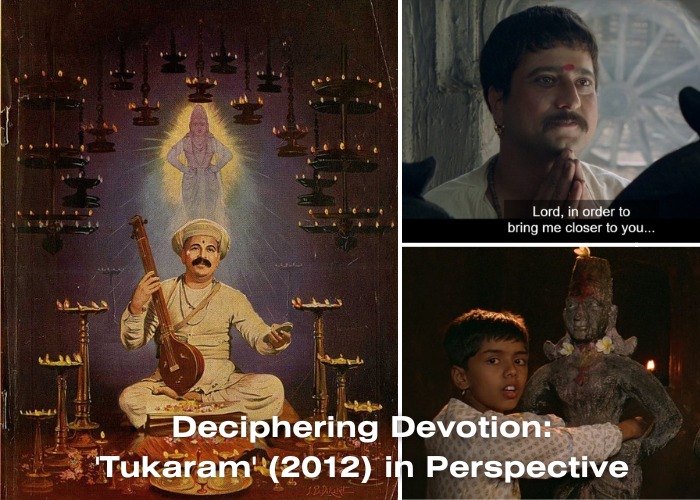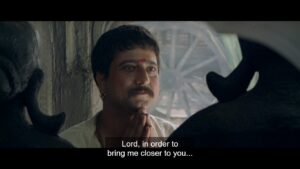Deciphering Devotion: ‘Tukaram’ in Perspective


-An article by Poojan Patel
“Tukaram” (2012) directed by Chandrakant Kulkarni is a Marathi biopic that delves into the life of Saint Tukaram, a 17th-century Varkari saint, spiritual poet, and ardent devotee of Vitthala. The film not only pays tribute to the legacy of this revered saint but also continues a cinematic tradition that began decades ago.


Set in the historical context of 17th-century Maharashtra, the film beautifully captures the essence of Sant Tukaram’s life, his deep spiritual quest, and the impact of his devotion on his family and society. As we journey through Tukaram’s life, we witness the complex interplay of faith, sacrifice, and human emotion.


The film portrays Tukaram’s unwavering devotion to Lord Vithoba, the central deity of his worship. Jitendra Joshi delivers a mesmerizing performance as Tukaram, embodying the saint’s spiritual fervor and inner turmoil. Through his portrayal, we are drawn into the soul-stirring world of devotion, where faith becomes a driving force and a source of profound inner transformation.
The film subtly addresses the issue of casteism prevalent in society during that period. It shows how Tukaram, as a saint, challenged caste-based discrimination and emphasized devotion to Lord Vithoba as the ultimate path to spiritual realization, transcending caste boundaries.
“Tukaram” is a cinematic gem that transports viewers to a world of profound devotion, philosophical exploration, and the enduring impact of one saint’s life on generations. Jitendra Joshi’s powerful portrayal, coupled with the film’s meticulous attention to historical and philosophical details, makes it a must-watch for those interested in the rich spiritual and cultural heritage of Maharashtra. “Tukaram” is a poignant reminder of the power of faith, the beauty of sacrifice, and the eternal quest for spiritual realization.
Recent Posts
સાંસદોને પગાર વધારાની જરૂર લાગે છે!?
24 ટકાના વધારા પછી લોકોના મનમાં એક જ સવાલ,સાંસદો 5 વર્ષમાં કેવી રીતે કરોડો કમાતા…
આજે વિશ્વ વન દિવસ..જાણો કેમ મહત્વનો છે આજનો દિવસ
દર મીનીટે 36 ફુટબોલ મેદાન જેટલા કુદરતી વનોનો નાશ થઇ રહ્યો છે. ભારતમાં 33%ને બદલે…
વિશ્વ કવિતા દિવસ 2025: કવિતાનું મહત્વ અને સમાજમાં તેની ભૂમિકા
આજે વિશ્વ કવિતા દિવસ છે ત્યારે પ્રેમ હુંફ અને લાગણીઓ સાથે કલ્પનાની દુનિયા ઉમેરાય અને…
ગુજરાત પોલીસનું ઓપરેશન પતાલલોક: ગુંડાઓ સામે કડક કાર્યવાહી
પોલીસનું ઓપરેશન પતાલલોક! ડીજીપીના આદેશ છુટતા બિલમાં સંતાયેલાને બહાર લાવી કાયદાનો ડંડો વીંઝાશે!ગુંડારાજ વધતા પોલીસ…
મસાનમાં ‘ભસ્મ હોળી’ કેમ રમાય છે જાણો?
આ અનોખી પરંપરા અનાદિ કાળથી ચાલતી હોવાનો દાવો.મસાન હોળી વારાણસીના મણિકર્ણિકા ઘાટ પર મનાવવામાં આવી.…
હજુ પણ ગુજરાતમાં જીવે છે અંધશ્રદ્ધા!
અંધશ્રદ્ધાના અંત માટે સ્વૈચ્છિક સંગઠનો અને સરકાર દ્વારા અભિયાનો ચલાવવામાં આવી રહ્યા છે. છતાં સમાજમાંથી…
